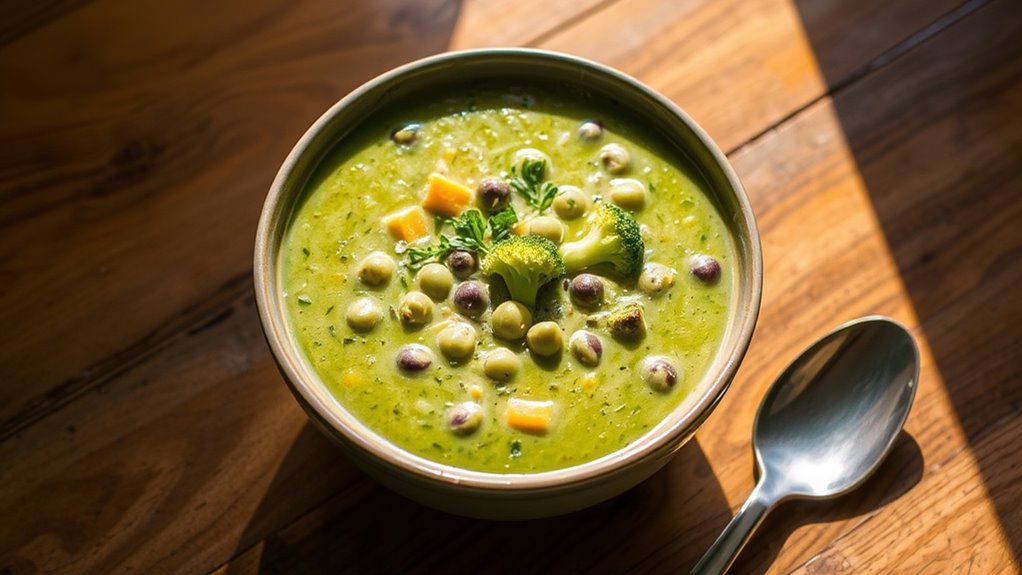You’ll start with a hearty base of sautéed aromatics, then stir in dried black-eyed peas (or pre-cooked) and broccoli, all anchored by a rich stock. Let it simmer to deepen flavor, then blend until creamy with an immersion blender and fold in shredded cheddar for a silky finish. Season to taste with salt, pepper, and a touch of acidity. Garnish with chives or croutons if you like, and keep exploring for more flavorful tweaks.
Ingredients and Quantity
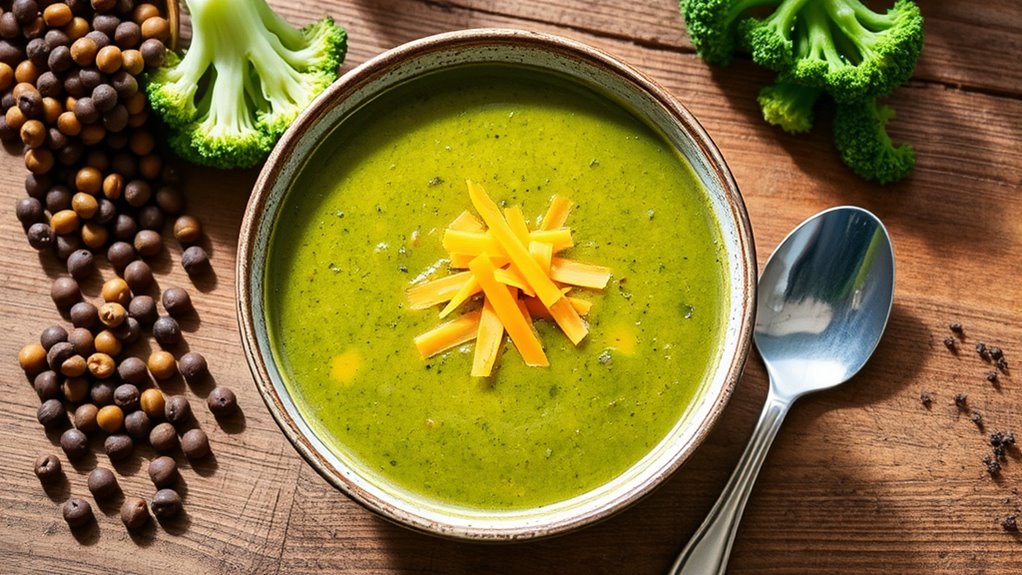
To make Black Eyed Pea Broccoli Cheese Soup, gather these ingredients: 1 cup dried black-eyed peas (or 2 cups cooked), 2 cups broccoli florets, 1 cup shredded cheddar, 1/2 cup diced onion, 2 cloves garlic, 4 cups vegetable or chicken broth, 1 cup milk or cream, 2 tablespoons butter, 1 tablespoon olive oil, salt and pepper to taste, and optional garnishes like chives or croutons. Nutritional benefits drive smarter choices, while Ingredient substitutions empower you to adapt. Table below highlights options at a glance.
| Base protein | Veg & greens | Dairy & fat |
|---|---|---|
| — | — | — |
| Black-eyed peas | Broccoli | Cheddar, milk/cream |
Preparations
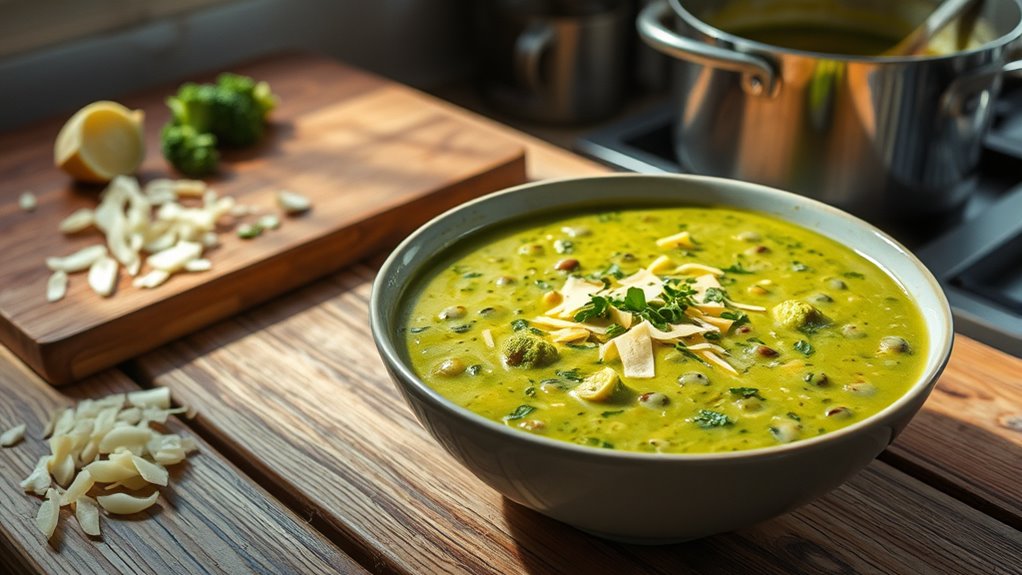
Once you’ve gathered the ingredients, the next step is to prep them so the soup comes together smoothly. You’ll want precise cuts, clean surfaces, and a mindful pace that respects flavors. Preparation touches—like trimming broccoli florets into bite-size spears and rinsing kale-or-spinach substitutes—set the base for texture and balance. The goal is efficiency without sacrificing taste, so plan ahead and screen for any off-notes before heating.
Carefully prep ingredients for a balanced, flavorful soup with precise, efficient cuts and clean surfaces.
- Slice broccoli into uniform florets, and dice any peppers or onions with minimal waste.
- Toss in steady, controlled motions; blot moisture from greens to avoid a watery broth.
- Consider preparation techniques that align with your pantry; note ingredient substitutions for a personalized attempt.
Kitchen tools or Kitchenware Required

Equipped to tackle this creamy, veggie-packed soup, you’ll want a focused set of kitchen tools that balance precision with simplicity. You’ll reach for a sturdy stockpot, a reliable wooden spoon, a soup ladle, and a sharp chef’s knife for prepping broccoli and greens. An immersion blender handles silky texture without fuss, while a colander makes quick rinses easy. A measuring cup helps with stock and dairy, and a heatproof spatula protects against scorching. To organize your workflow, consider a small triage setup: prep, blend, serve.
| Step | Tool | Purpose |
|---|---|---|
| 1 | Stockpot | Base cooking |
| 2 | Immersion blender | Puree to creaminess |
| 3 | Soup ladle | Portioning and serving |
How to Cook
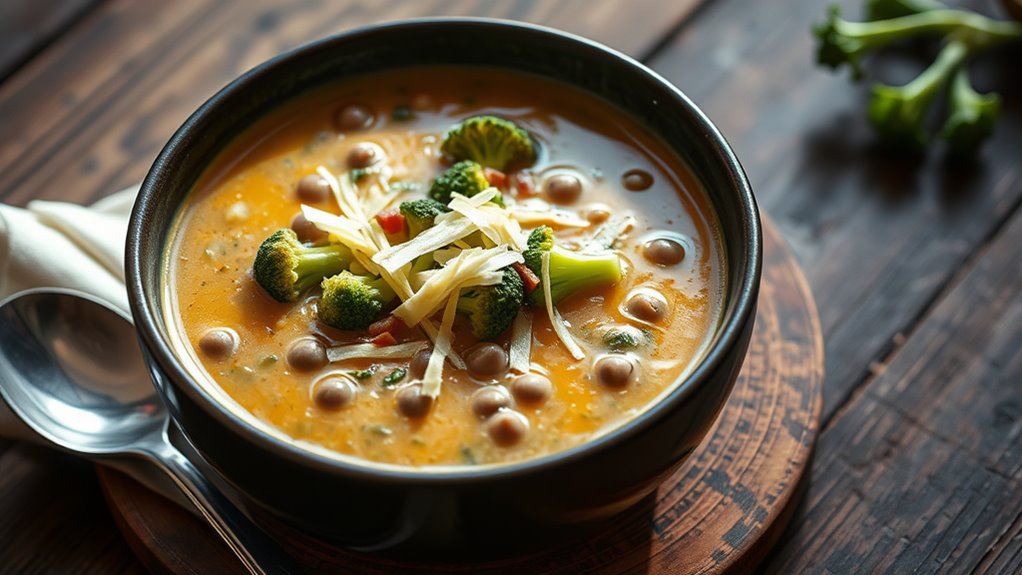
- Line up your tools and ingredients to prepare for cooking.
- Sauté aromatics first to build flavor.
- Add peas and broccoli, then anchor with stock to coax out sweetness without dullness.
- Maintain a slow simmer to build depth of flavor.
- Stir in cheese near the end to prevent graininess.
- Taste and adjust seasoning with salt, pepper, and a touch of acidity to brighten the soup.
- Finish with a final simmer to meld flavors.
- Adjust thickness to achieve a velvety, spoonable consistency suitable for diverse serving styles.
How to Serve
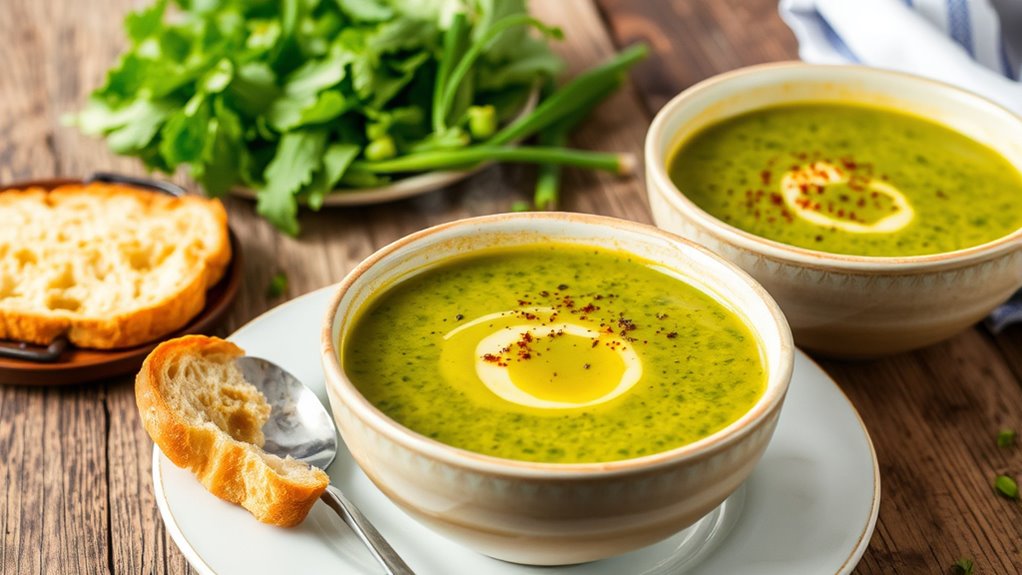
To serve Black Eyed Pea Broccoli Cheese Soup, ladle it into warm bowls and offer crusty bread or toast on the side for dipping. You’ll want steady portions that invite second helpings without drowning the flavors. Pair with a simple green salad to cut richness and brighten the plate. Serving temperature matters: keep the soup just steaming enough to lift aromas but not scorch your tongue. For serving suggestions, present bowls with a light drizzle of olive oil and a crack of black pepper to awaken the dairy and greens. Garnishing ideas include shaved cheddar, minced chives, or a pinch of hot paprika for color and contrast. This approach respects freedom, clarity, and the unapologetic joy of good, honest comfort.
Tips
Wondering how to elevate this Black Eyed Pea Broccoli Cheese Soup from good to memorable? You’re chasing concise, practical tweaks that respect texture and tempo. Think artistry in a simmer: richer broth, brighter florets, sharper cheese. Swap in a touch of smoked paprika or mustard powder for quick flavor enhancements, then adjust salt in small increments to avoid dulling broccoli sweetness.
1) Try soup variations by finishing with a swirl of pesto or a splash of reserved lemon juice to brighten the finish.
2) Layer flavor enhancements with roasted garlic, a pinch of chili, and a grated sharp cheddar for depth.
3) Experiment with creaminess by folding in a spoonful of sour cream or yogurt after off-heat, preserving balance and body.
Food Value and Benefit
This Black Eyed Pea Broccoli Cheese Soup is a nutrient-rich dish that provides a balanced combination of macronutrients and essential vitamins and minerals. It supports sustained energy levels and promotes overall health.
Food Value:
- Plant-based protein and fiber from black eyed peas
- Vitamins C and K from broccoli
- Calcium and protein from cheese
- Complex carbohydrates for steady energy
- Moderate healthy fats
Vitamins and Minerals:
- Vitamin C (broccoli) – supports immune health
- Vitamin K (broccoli) – important for blood clotting and bone health
- Calcium (cheese) – essential for strong bones and teeth
- Iron (black eyed peas) – supports oxygen transport in the blood
- Fiber (black eyed peas and broccoli) – promotes digestive health
- Potassium (broccoli) – helps regulate blood pressure
Benefits of Eating This Recipe:
- Provides sustained energy without blood sugar spikes
- Supports immune function through antioxidant vitamins
- Promotes digestive health with high fiber content
- Enhances bone strength with calcium and vitamin K
- Helps meet daily vegetable intake easily
- Encourages balanced macronutrient intake for satiety and wellness
Frequently Asked Questions
Can I Use Canned or Dried Black-Eyed Peas Interchangeably?
You can’t swap them one-for-one. Canned benefits: faster, ready-to-use with flavor; dried drawbacks: need soaking and longer cooking. You’ll save time with canned, but enjoy richer texture and control when you tackle dried peas.
What Substitutes Work Best for Broccoli in This Soup?
“Time is money,” so you swap broccoli with spinach alternatives or cauliflower options that melt smoothly and keep texture. You’ll love starchy bodies; you’ll adore mild greens. You’ll keep flavor bold, freeing you to improvise without guilt.
How Long Can Leftovers Be Safely Stored in the Fridge?
Leftovers keep safely in the fridge for about 3 to 4 days. For ideal food safety, store promptly in airtight containers, label dates, and reheat to steaming hot. Beyond that, discard to avoid unseen risks. Stay savvy, freedom-loving foodie.
Can This Recipe Be Made Dairy-Free Without Losing Flavor?
Yes, you can make it dairy-free without losing flavor. Use dairy alternatives like cashew cream or coconut milk, and flavor enhancers like nutritional yeast, smoked paprika, and garlic. Your crave-worthy dish stays bold, balanced, and crave-worthy for freedom lovers.
Is This Soup Suitable for Freezing and Reheating Later?
Yes, you can freeze and reheat later. For best results, follow freezing tips like cooling fully, portioning, and airtight containers; reheating methods: gentle stovetop or microwave, stirring often, and avoiding scorching to preserve texture and flavor.
